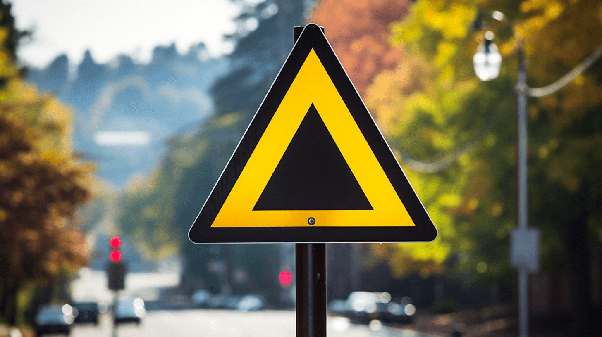Yielding the Right of Way: Understanding the Red and White Triangular Sign
At intersections, a symphony of signs guides drivers towards safe and efficient traffic flow. Among these, the red and white triangular sign stands out, a universal symbol for yielding the right of way. This article dives deep into the meaning and proper response to this crucial traffic signal, ensuring smooth navigation through intersections.
The Shape and Colors: A Universal Language
The red and white triangular sign is a globally recognized symbol for yielding. The specific shade of red and white may vary slightly depending on the country, but the core design remains consistent.
- Red: This universally recognized color signifies stop, danger, or the need for caution.
- Triangle: The triangular shape inherently conveys a sense of urgency and grabs attention.
Combining these elements, the red and white triangle effectively communicates the need to yield the right of way to approaching traffic.
Yield vs. Stop: Understanding the Distinction
While both the red and white triangular sign and the red octagonal stop sign might seem similar at first glance, they hold crucial distinctions:
- Yield Sign: Instructs drivers to slow down and stop if necessary to allow vehicles or pedestrians already in the intersection to proceed safely.
- Stop Sign: Requires drivers to come to a complete stop, even if the intersection appears clear. They can only proceed after ensuring it’s safe to do so.
Yielding signifies a courtesy and awareness of potential conflicts, while a stop sign demands a complete halt and prioritizes traffic already in the intersection.
Proper Response to a Yield Sign
Encountering a red and white triangular sign necessitates specific actions to ensure safety:
- Slow Down: Gradually reduce your speed as you approach the intersection.
- Look Both Ways: Carefully scan for oncoming traffic from both the left and right.
- Yield the Right of Way: If there are vehicles or pedestrians already in the intersection, come to a complete stop and allow them to pass before proceeding.
- Proceed with Caution: If the intersection is clear, proceed slowly, remaining vigilant of potential hazards.
Remember, yielding is not a race to enter the intersection first. It’s about ensuring everyone’s safety and creating a smooth flow of traffic.
Common Scenarios and Yielding Practices
Here are some specific scenarios where yielding is crucial:
- Entering a Multi-Lane Road from a Side Street: Yield to traffic already on the main road before merging.
- Right Turn on Red: Even with a green arrow, come to a complete stop and yield to pedestrians or oncoming traffic before turning.
- Roundabout: Yield to traffic already circulating within the roundabout before entering.
Understanding these scenarios and practicing proper yielding behavior significantly reduces the risk of accidents at intersections.
The Importance of Yielding: Safety and Efficiency
Yielding is not just a traffic rule; it’s a core principle of safe driving. Here’s why it matters:
- Reduces Accidents: Yielding prevents collisions by ensuring right of way is given to those already in the intersection.
- Improves Traffic Flow: Smooth yielding minimizes hesitation and delays, keeping traffic moving efficiently.
- Promotes Courtesy: Yielding demonstrates consideration for other drivers and pedestrians, fostering a more positive driving environment.
By understanding and practicing proper yielding techniques, drivers contribute to a safer and more courteous driving culture on the road.
Frequently Asked Questions (FAQ)
1. When should I not yield at a yield sign?
You generally shouldn’t yield if oncoming traffic is far enough away that you can safely enter the intersection without causing them to slow down or stop. However, always prioritize safety. If there’s any doubt, err on the side of caution and yield.
2. Can I get a ticket for not yielding?
Yes, failing to yield the right of way can result in a traffic citation.
3. Who has the right of way at a yield sign with a stop sign?
Traffic approaching the intersection with the stop sign must come to a complete stop and yield the right of way to all vehicles already in the intersection or approaching from the yield sign.
4. What if multiple cars approach a yield sign at the same time?
The car that arrives at the yield sign first generally has the right of way. If unsure, proceed with caution and make eye contact with other drivers to establish who will yield.
5. Are there any exceptions to yielding?
Yielding is generally expected unless otherwise indicated by traffic lights, police officers, or malfunctioning signs.






More Stories
Where to Watch USMNT vs Jamaica National Football Team
How I Met My Monster
How Should a Ring Fit